Christy Mathewson
Christopher Mathewson (August 12, 1880 – October 7, 1925), nicknamed "Big Six", "The Christian Gentleman", "Matty", and "The Gentleman's Hurler", was a Major League Baseball right-handed pitcher, who played 17 seasons with the New York Giants. He stood 6 feet 1 inch (1.85 m) tall and weighed 195 pounds (88 kg). He was among the most dominant pitchers in baseball history, and ranks in the all-time top 10 in several key pitching categories, including wins, shutouts, and ERA.[1] In 1936, Mathewson was elected into the Baseball Hall of Fame as one of its first five members.
| Christy Mathewson | |||||||||||||||||||||||||||||||||||||||||||
|---|---|---|---|---|---|---|---|---|---|---|---|---|---|---|---|---|---|---|---|---|---|---|---|---|---|---|---|---|---|---|---|---|---|---|---|---|---|---|---|---|---|---|---|
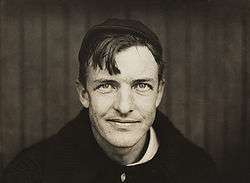 | |||||||||||||||||||||||||||||||||||||||||||
| Pitcher | |||||||||||||||||||||||||||||||||||||||||||
| Born: August 12, 1880 Factoryville, Pennsylvania | |||||||||||||||||||||||||||||||||||||||||||
| Died: October 7, 1925 (aged 45) Saranac Lake, New York | |||||||||||||||||||||||||||||||||||||||||||
| |||||||||||||||||||||||||||||||||||||||||||
| MLB debut | |||||||||||||||||||||||||||||||||||||||||||
| July 17, 1900, for the New York Giants | |||||||||||||||||||||||||||||||||||||||||||
| Last MLB appearance | |||||||||||||||||||||||||||||||||||||||||||
| September 4, 1916, for the Cincinnati Reds | |||||||||||||||||||||||||||||||||||||||||||
| MLB statistics | |||||||||||||||||||||||||||||||||||||||||||
| Win–loss record | 373–188 | ||||||||||||||||||||||||||||||||||||||||||
| Earned run average | 2.13 | ||||||||||||||||||||||||||||||||||||||||||
| Strikeouts | 2,502 | ||||||||||||||||||||||||||||||||||||||||||
| Managerial record | 164–176 | ||||||||||||||||||||||||||||||||||||||||||
| Winning % | .482 | ||||||||||||||||||||||||||||||||||||||||||
| Teams | |||||||||||||||||||||||||||||||||||||||||||
As player
As manager | |||||||||||||||||||||||||||||||||||||||||||
| Career highlights and awards | |||||||||||||||||||||||||||||||||||||||||||
| |||||||||||||||||||||||||||||||||||||||||||
| Member of the National | |||||||||||||||||||||||||||||||||||||||||||
| Induction | 1936 | ||||||||||||||||||||||||||||||||||||||||||
| Vote | 90.7% (first ballot) | ||||||||||||||||||||||||||||||||||||||||||
| |||||||||||||||||||||||||||||||||||||||||||
Mathewson grew up in Factoryville, Pennsylvania, and began playing semiprofessional baseball when he was 14 years old. He played in the minor leagues in 1899, recording a record of 21 wins and two losses. He pitched for the New York Giants the next season, but was sent back to the minors. He eventually returned to the Giants, and went on to win 373 games in his career, a National League record. He led the Giants to victory in the 1905 World Series by pitching three shutouts. Mathewson never pitched on Sundays, owing to his Christian beliefs. Mathewson served in the United States Army's Chemical Warfare Service in World War I, and was accidentally exposed to chemical weapons during training. His respiratory system was weakened from the exposure, causing him to contract tuberculosis, from which he died in Saranac Lake, New York in 1925.
Early life
Mathewson was born in Factoryville, Pennsylvania and attended high school at Keystone Academy. He attended college at Bucknell University, where he served as class president and played on the school's football, basketball, and baseball teams.[2] He was also a member of the fraternity of Phi Gamma Delta.[3] His first experience of semiprofessional baseball came in 1895, when he was just 14 years old.[4] The manager of the Factoryville ball club asked him to pitch in a game with a rival team in Mill City, Pennsylvania.[4] Mathewson helped his hometown team to a 19-17 victory, but with his batting rather than his pitching.[4] He continued to play baseball during his years at Bucknell, pitching for minor league teams in Honesdale and Meridian, Pennsylvania.[5] Mathewson was selected to the Walter Camp All-American football team in 1900. He was a drop-kicker.[6]
Professional career
Minor league career and early major league career
_(LOC).jpg)
In 1899, Mathewson signed to play professional baseball with Taunton of the New England League. The next season, he moved on to play on the Norfolk team of the Virginia-North Carolina League. He finished that season with a 20–2 record.[7] He continued to attend Bucknell during that time.
In July of that year, the New York Giants purchased his contract from Norfolk for $1,500 (equivalent to $46,000 in 2019).[7][8] Between July and September 1900, Mathewson appeared in six games for the Giants. He started one of those games and compiled a 0–3 record. Displeased with his performance, the Giants returned him to Norfolk and demanded their money back.[7] Later that month, the Cincinnati Reds picked up Mathewson off the Norfolk roster. On December 15, 1900, the Reds quickly traded Mathewson back to the Giants for Amos Rusie.[8]
Football career
Mathewson played football at Keystone Academy from 1895 to 1897.[9] He turned pro in 1898, appearing as a fullback with the Greensburg Athletic Association.[10] While a member of the New York Giants, Mathewson played fullback for the Pittsburgh Stars of the first National Football League. However, Mathewson disappeared from the team in the middle of the team's 1902 season. Some historians speculate that the Giants got word that their star pitcher was risking his baseball career for the Stars and ordered him to stop, while others feel that the Stars' coach, Willis Richardson, got rid of Mathewson because he felt that, since the fullback's punting skills were hardly used, he could replace him with a local player, Shirley Ellis.[11]
Career with the Giants
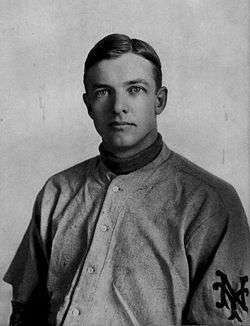
During his 17-year career, Mathewson won 373 games and lost 188 for a .665 winning percentage. His career ERA of 2.13 and 79 career shutouts are among the best all time for pitchers, and his 373 wins are still number one in the National League, tied with Grover Cleveland Alexander. He employed a good fastball, outstanding control, and, especially a new pitch he termed the "fadeaway" (later known in baseball as the "screwball"), which he learned from teammate Dave Williams in 1898.[12]
This reference is challenged by Ken Burns documentary Baseball in which it is stated that Mathewson learned his "fadeaway" from Andrew "Rube" Foster when New York Giants manager John Joseph McGraw quietly hired Rube to show the Giants bullpen what he knew. Many baseball historians consider this story apocryphal.
Mathewson recorded 2,507 career strikeouts against only 848 walks. He is famous for his 25 pitching duels with Mordecai "Three Finger" Brown, who won 13 of the duels against Mathewson's 11, with one no-decision.[13]
Mathewson was a very good-hitting pitcher in his major league career, posting a .215 batting average (362-for-1687) with 151 runs, seven home runs, and 167 RBI. In 10 of his 17 years in the majors, he was in double figures in RBIs, with a season-high of 20 in 1903. He batted .281 (9-for-32) in 11 World Series games.
From 1900 to 1904, Mathewson established himself as a premier pitcher. Posting low ERAs and winning nearly 100 games, Mathewson helped McGraw raise the Giants' place in the standings. Though no World Series was held in 1904, the Giants captured the pennant, prompting McGraw to proclaim them as the best team in the world.
Mathewson strove even harder in 1905. After switching to catcher, Roger Bresnahan had begun collaborating with Mathewson, whose advanced memory of hitter weaknesses paved the way for a historic season. Pinpoint control guided Mathewson's pitches to Bresnahan's glove. In 338 innings, Mathewson walked only 64 batters. He shut out opposing teams eight times, pitching entire games in brief 90-minute sessions. Besides winning 31 games, Mathewson allowed only 1.28 earned runs for every nine innings. His 206 strikeouts led the league, earning him the Triple Crown.[14]
Mathewson's Giants won the 1905 World Series over the Philadelphia Athletics. Mathewson was the starting pitcher in game one, and pitched a four-hit shutout for the victory. Three days later, with the series tied 1–1, he pitched another four-hit shutout. Then, two days later in game five, he threw a six-hit shutout to clinch the series for the Giants. In a span of only six days, Mathewson had pitched three complete games without allowing a run, while giving up only 14 hits.
In the next year, Mathewson lost much of his edge, owing to an early-season diagnosis of diphtheria. McGraw pulled over 260 innings from him, but these were plagued with struggle. Though he maintained a 22-12 record, his 2.97 ERA was well above the league average of 2.62. His 1.271 WHIP, quite uncharacteristic of him, was due to an increased number of hits and walks.
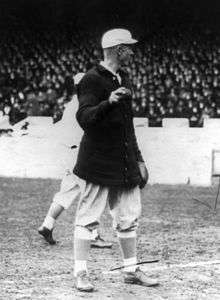
By 1908, Mathewson was back on top as the league's elite pitcher. Winning the most games of his career, 37, coupled with a 1.43 ERA and 259 strikeouts, he claimed a second Triple Crown. He also led the league in innings pitched and shutouts, and held hitters to an exceptionally low 0.827 WHIP. Unfortunately, the Giants were unable to take home the pennant due to what was ultimately known as Merkle's Boner, an incident that cost the Giants a crucial game against the Chicago Cubs, who eventually defeated the Giants in the standings by one game.
Mathewson returned for an incredible 1909 season, posting better numbers than the previous year. He repeated a strong performance in 1910 and then again in 1911, when the Giants captured their first pennant since 1905. The Giants ultimately lost the 1911 World Series to the Philadelphia Athletics, the same team they had defeated for the 1905 championship. Mathewson and Rube Marquard allowed two game-winning home runs to Hall of Famer Frank Baker, earning him the nickname, "Home Run".[14] Mathewson, the team's "star pitcher", signed a three-year contract with the Giants in late 1910, for the upcoming 1911, 1912 and 1913 seasons, the first time he had signed a contract over a year in length. [15]
In 1912, Mathewson gave another stellar performance. Capturing the pennant, the Giants were fueled by the stolen-base game and a superior pitching staff capped by Rube Marquard, the "11,000-dollar lemon" who turned around to win 26 games, 19 of them consecutively. In the 1912 World Series, the Giants faced the Boston Red Sox, the 1904 American League pennant winners who were to face the Giants in the World Series that year had it not been cancelled. Though Mathewson threw three complete games and maintained an ERA below 1.00, numerous errors by the Giants, including a lazy popup dropped by Fred Snodgrass in game seven, cost them the championship.[16] The Giants also lost the 1913 World Series, a 101-win season cemented by Mathewson's final brilliant season on the mound: a league-leading 2.06 ERA in over 300 innings pitched complemented by 0.6 bases on balls per nine innings pitched.
For the remainder of his career with the Giants, Mathewson began to struggle. Soon, the former champions fell into decline. In 1915, Mathewson's penultimate season in New York, the Giants were the worst team in the National League standings. Mathewson, who had expressed interest in serving as a manager, wound up with a three-year deal to manage the Cincinnati Reds effective July 21, 1916.[14]
Three years with the Reds
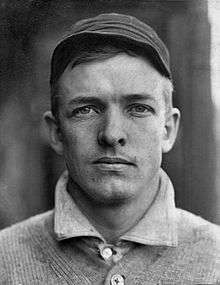
On July 20, 1916, Mathewson's career came full circle when he was traded to the Cincinnati Reds along with Edd Roush. He was immediately named as the Reds' player-manager. However, he appeared in only one game as a pitcher for the Reds, on September 4, 1916. He faced Brown in the second half of a doubleheader, which was billed as the final meeting between the two old baseball warriors. The high-scoring game was a win for Mathewson's Reds over Brown's Cubs, 10-8.[17]
Mathewson retired as a player after the season and managed the Reds for the entire 1917 season and the first 118 games of 1918, compiling a total record of 164-176 as a manager.[17]
Personal life and literary career

Mathewson married wife Jane in 1903. Their only son, Christopher Jr., was born shortly after. Christy Mathewson Jr. served in World War I, and died in an explosion at his home in Texas in 1950. During Mathewson's playing years, the family lived in a duplex in upper Manhattan alongside Mathewson's manager John McGraw and his wife Blanche. Mathewson and McGraw remained friends for the rest of their lives. In the 1909 offseason, Christy Mathewson's younger brother Nicholas Mathewson committed suicide in a neighbor's barn. Another brother, Henry Mathewson, pitched briefly for the Giants before dying of tuberculosis in 1917.
Mathewson was highly regarded in the baseball world during his lifetime. As he was a clean-cut, intellectual collegiate, his rise to fame brought a better name to the typical ballplayer, who usually spent his time gambling, boozing, or womanizing. As noted in The National League Story (1961) by Lee Allen, Mathewson was a devout Christian and never pitched on Sunday, a promise he made to his mother that brought him popularity among the more religious New York fans. However, the impact of this practice on the Giants was minimized, since, in the eight-team National League, only the Chicago Cubs (Illinois), Cincinnati Reds (Ohio), and St. Louis Cardinals (Missouri) played home games in states that allowed professional sports on Sunday.
In his free time, Mathewson enjoyed nature walks, reading, golf, and checkers, of which he was a renowned champion player. The combination of athletic skill and intellectual hobbies made him a favorite for many fans, even those opposed to the Giants. Sportswriters praised him, and in his prime every game he started began with deafening cheers. Sometimes, the distraction prompted him to walk out 10 minutes after his fielders took the field. Mathewson soon became the unspoken captain of the Giants. He was the only player to whom John McGraw ever gave full discretion. McGraw told many younger players to watch and listen to his wisdom.
Mathewson garnered respect throughout the baseball world as a pitcher of great sportsmanship. He was often asked to write columns concerning upcoming games. In 1912, Mathewson published his classic memoir Pitching in a Pinch, or Pitching from the Inside,[18] which was admired by poet Marianne Moore[19] and still in print.[20] Years later, Mathewson co-wrote a mildly successful play called The Girl and The Pennant. He went on to pursue more literary endeavors ending in 1917 with a children's book called Second Base Sloan.[21] One of the journalists to unmask the 1919 Black Sox, Hugh Fullerton, consulted Mathewson for information about baseball gambling. He trusted Mathewson for his writing intellect, as well as his unbiased standpoint. Representing the only former ballplayer among the group of investigating journalists, Mathewson played a small role in Fullerton's exposure of the 1919 World Series scandal.[14]
World War I and afterward
Late in the 1918 season, Mathewson enlisted in the United States Army for World War I. His wife Jane was very much opposed to the decision, but Mathewson insisted on going.[22] He served overseas as a captain in the newly formed Chemical Service along with Ty Cobb. When he arrived in France, he was accidentally gassed during a chemical training exercise and subsequently developed tuberculosis,[2] which more easily infects lungs that have been damaged by chemical gases. Mathewson served with the American Expeditionary Forces until February 1919 and was discharged later that month.[23]
Although he returned to serve as a coach for the Giants from 1919–1921, he spent a good portion of that time in Saranac Lake fighting the tuberculosis, initially at the Trudeau Sanitorium, and later in a house that he had built.[7] In 1923, Mathewson returned to professional baseball when Giants attorney Emil Fuchs and he put together a syndicate that bought the Boston Braves. Although initial plans called for Mathewson to be principal owner and team president, his health had deteriorated so much that he was no more than a figurehead. He turned over the presidency to Fuchs after the season.
Death and legacy
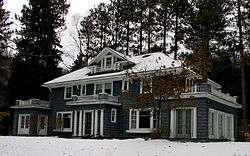

After contracting tuberculosis, Mathewson moved to the frigid climate of Saranac Lake, New York in the Adirondack Mountains, where he sought treatment from Edward Livingston Trudeau at his renowned Adirondack Cottage Sanitarium. He died in Saranac Lake, New York, of tuberculosis on October 7, 1925. Mathewson is buried at Lewisburg Cemetery in Lewisburg, Pennsylvania, adjacent to Bucknell University. Members of the Pittsburgh Pirates and the Washington Senators wore black armbands during the 1925 World Series. Mathewson had died on the day the series began, October 7. According to Baseball, some of Mathewson's last words were to his wife: "Now Jane, I want you to go outside and have yourself a good cry. Don't make it a long one; this can't be helped."
- Christy Mathewson Day is celebrated as a holiday in his hometown of Factoryville, Pennsylvania, on the Saturday closest to his birthday.
- Christy Mathewson Day and Factoryville, Pennsylvania, are the subjects of the documentary, Christy Mathewson Day.[24]
- Bucknell's football stadium is named "Christy Mathewson–Memorial Stadium".
- The baseball field at Keystone College is named "Christy Mathewson Field".
- Christy Mathewson Park in Factoryville is home to the community's Little League field, as well as basketball courts and other athletic facilities, public gardens, walking trails, and a picnic pavilion.
- The former Whittenton Ballfield in Taunton, Massachusetts, is named in memory of Christy Mathewson, who played for the Taunton team in the New England Baseball League before he joined the New York Giants.
- Mathewson is mentioned in the poem "Line-Up for Yesterday" by Ogden Nash.
- F. Scott Fitzgerald refers to "Christy Mathewson" in his first novel, This Side of Paradise (1920).[25]
- Jazz pianist Dave Frishberg, composer of several baseball-themed songs, wrote one called "Matty" for Mathewson.
- Mathewson is a central character in Eric Rolfe Greenberg's historical novel The Celebrant,[26] which chronicles turn-of-the-century American life by weaving together Mathewson's story with the life of an immigrant Jewish family in New York. In 2002, the book was selected as one of the top 100 sports books of all time by Sports Illustrated.[27]
Baseball honors
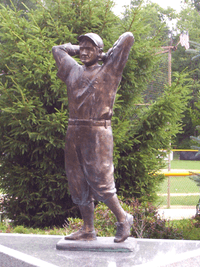
- In 1936, Mathewson was elected into the Baseball Hall of Fame as one of its first five inductees, along with Babe Ruth, Ty Cobb, Walter Johnson, and Honus Wagner. He was the only one of the five to be inducted posthumously.[28]
- His jersey, denoted as "NY", has been retired by the Giants and hangs in the left-field corner of Oracle Park. Uniform numbers were not used during the time when Mathewson played for the Giants.
- In 1999, he ranked number seven on The Sporting News' list of the 100 Greatest Baseball Players, the highest-ranking National League pitcher.
- ESPN selected his pitching performance in the 1905 World Series as the greatest playoff performance of all time.[29]
- During World War II, a 422-foot Liberty ship named in his honor, USS Christy Mathewson, was built in Richmond, California, in 1943.
- His plaque at the Baseball Hall of Fame says: "Greatest of all of the great pitchers in the 20th century's first quarter" and ends with the statement: "Matty was master of them all"
Filmography
(compiled per IMDb)
- Christy Mathewson and the New York National League Team (1907)
- Athletics vs. Giants in the World's Championship Baseball Series of 1911 (1911)
- Breaking into the Big League (1913)
- The Giants-White Sox Tour (1914) *short actuality
- The Universal Boy (1914)
- Love and Baseball (1914)
- Matty's Decision (1915)
- Animated Weekly, No.16 (1916)
- Animated Weekly, No.31 (1916)
- The Baseball Revue of 1917 (1917)
Works
- Won in the Ninth (1910)
- Pitching in a Pinch; or, Baseball from the Inside (1912)
- Pitcher Pollock (1914)
- Catcher Craig (1915)
- Second Base Sloan (1917)
See also
Who carried a charm
In the form of an extra
brain in his arm.
— Ogden Nash, Sport magazine (January 1949)[30]
- 300 win club
- List of Major League Baseball career wins leaders
- Major League Baseball Triple Crown
- List of Major League Baseball annual saves leaders
- List of Major League Baseball annual shutout leaders
- List of Major League Baseball annual strikeout leaders
- List of Major League Baseball annual wins leaders
- List of Major League Baseball career strikeout leaders
- Major League Baseball titles leaders
- List of Major League Baseball no-hitters
- List of Major League Baseball player-managers
References
- "MLB & Baseball Leaders & Records". Baseball-Reference.com. Retrieved November 25, 2013.
- "Christy Mathewson". HistoricBaseball.com. Retrieved October 28, 2006.
- "Christy Mathewson". Phigam.org. Archived from the original on September 27, 2007. Retrieved March 16, 2007.
- Kashatus, William C. (2002). Diamonds in the Coalfields: 21 Remarkable Baseball Players, Managers, and Umpires from Northeast Pennsylvania. Jefferson, North Carolina: McFarland & Company., p. 27.
- Kashatus, William C. (2002). Diamonds in the Coalfields: 21 Remarkable Baseball Players, Managers, and Umpires from Northeast Pennsylvania. Jefferson, North Carolina: McFarland & Company., p. 33.
- Russell, Fred. "Sidelines: Little-Known Fact About Matty", Nashville Banner, December 22, 1958.
- "Christy Mathewson". BaseballLibrary.com. Archived from the original on February 6, 2007. Retrieved October 28, 2006.
- "Christy Mathewson". Baseball-Reference.com. Retrieved January 31, 2007.
- "Keystone Adds Football as 22nd Varsity Sport".
- Goodwin, Stew (Summer 1994). "Hall-of-Famers on the Early Gridiron" (PDF). The National Pastime. Cleveland, Ohio: Society for American Baseball Research. 14: 97–98. ISBN 0-910137-56-0. Retrieved August 15, 2012.
- Carroll, Bob (1980). "Dave Berry and the Philadelphia Story" (PDF). Coffin Corner. Professional Football Researchers Association. 2 (Annual): 1–9. Archived from the original (PDF) on November 27, 2010.
- Bill James & Rob Neyer (2004). The Neyer/James Guide to Pitchers. p. 296.
- "The Ballplayers: Christy Mathewson". BaseballLibrary.com. September 4, 1916. Archived from the original on April 14, 2009. Retrieved April 3, 2009.
- Robinson, Ray (1994). Matty : an American hero. New York: Oxford University Press. ISBN 978-0-19-509263-9.
- "Matty Signs up for Three Years". The Ogdensburg Journal. Ogdensburg, NY. November 15, 1910. Retrieved October 16, 2019.
- Vaccaro, Mike (2009). First Fall Classic. New York: Doubleday.
- Okrent, Daniel (1988). The Ultimate Baseball Book. United States: Hilltown Press. p. 80. ISBN 0395361451.
- Mathewson, Christy (1912). Pitching in a Pinch, or Baseball from the Inside. G.B. Putnam & Sons. ISBN 0812821963.
- Hemispheres, Grace Shulman; Grace Schulman is the author of Marianne Moore: The Poetry of Engagement Her latest book of poems is (November 30, 1986). "A Gusto for Dumbo and Balanchine". The New York Times. ISSN 0362-4331. Retrieved February 22, 2018.
- 1880-1925., Mathewson, Christy (1994). Pitching in a pinch, or, Baseball from the inside. Greenberg, Eric Rolfe., Wheeler, John N. (John Neville), 1886-1973. Lincoln: University of Nebraska Press. ISBN 9780803282124. OCLC 29430072.CS1 maint: numeric names: authors list (link)
- Mathewson, Christy (1917). Second Base Sloan. New York: Dodd, Meade & Co.
- Hartley, Michael (2004). Christy Mathewson: a biography. Jefferson, N.C.: McFarland & Co. ISBN 978-0-7864-1653-0.
- Official Roster of Ohio Soldiers, Sailors and Marines, World War 1917-18. Columbus, Ohio: Ohio Adjutant-General's Department. 1926. p. 10886.
- "Christy Mathewson Day". 23circles Productions. 2011. Retrieved November 25, 2013.
- Fitzgerald, F. Scott; Fitzgerald (l896-l940), F. Scott (Francis Scott Key); West, James L. W. (1995). This Side of Paradise. Cambridge University Press. ISBN 978-0-521-40234-7.
- Greenberg, Eric Rolfe (1983). The Celebrant: A Novel. Lincoln: University of Nebraska Press. ISBN 978-0-8032-7037-4.
- McEntegart, Pete. "The Top 100 Sports Books of All Time". SI.com. Sports Illustrated. Retrieved July 4, 2017.
- Kashatus, William C. (2002). Diamonds in the Coalfields: 21 Remarkable Baseball Players, Managers, and Umpires from Northeast Pennsylvania. Jefferson, North Carolina: McFarland & Company, p. 120.
- "50 Greatest Playoff Performances". espn.com. Retrieved August 20, 2008.
- "Line-Up For Yesterday by Ogden Nash". Ogden Nash. Sport Magazine. Retrieved August 20, 2008.
Further reading
- Carroll, Bob (1980). "Dave Berry and the Philadelphia Story" (PDF). Coffin Corner. Professional Football Researchers Association. 2 (Annual): 1–9. Archived from the original (PDF) on November 27, 2010.
- Gaines, Bob. 2015. Christy Matthewson: The Christian Gentleman. Lanham, MD: Rowman & Littlefield.
- Peterson, Robert W. (1997). Pigskin: The Early Years of Pro Football. Oxford University Press. ISBN 9780195353303.
Works
- Christy Mathewson, "'Outguessing' the Batter," Pearson's Magazine, vol. 25, no. 5 (May 1911), pp. 568–575.
External links
| Wikimedia Commons has media related to Christy Mathewson. |
- Career statistics and player information from MLB, or ESPN, or Baseball-Reference, or Fangraphs, or Baseball-Reference (Minors)
- Christy Mathewson managerial career statistics at Baseball-Reference.com
- christymathewson.com Official site
- Christy Mathewson on IMDb
- Baseball Almanac list of brothers
- SABR Christy Mathewson biography
- Works by Christy Mathewson at Project Gutenberg
- Works by or about Christy Mathewson at Internet Archive
- Works by Christy Mathewson at LibriVox (public domain audiobooks)

| Preceded by Noodles Hahn Jesse Tannehill |
No-hitter pitcher July 15, 1901 June 13, 1905 |
Succeeded by Nixey Callahan Weldon Henley |